The Bulgarian Lev
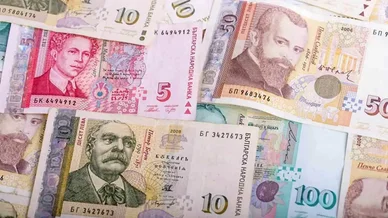
The Bulgarian Lev (BGN, ЛВ) is the official currency of Bulgaria. It circulates only within the country’s territory and is not a freely convertible currency. The subunit is stotinka: 1 lev = 100 stotinki.

History
Bulgarian money has had five stages of development. The first means of payment emerged 500 years after the First Bulgarian Empire was established. These were the aspr coins minted by tsar Ivan Shishman.
Bulgarian clergy attempted to create their money during Ottoman rule to manage internal calculations and accounts. In the idea of Bishop Genev, the money had to look like square-shaped pieces of metal with the image of the cross. However, the Turkish authorities saw that intention as a venture of counterfeiting. Moreover, they wanted to cut the arm of the clergyman who organised the minting of square-cut coins.
The first leva as full-bodied money appeared in Bulgaria in 1879, when the country became free from Ottoman domination. In the same year, the Bulgarian National Bank was established as the issuing body. It issues banknotes even nowadays.
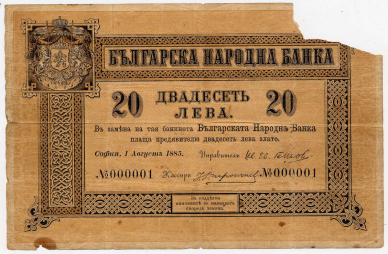
The First Bulgarian Lev Banknote Frontside
The Bulgarian national currency began to be called lev in 1880 under the new law adopted at the same time. Lev was immediately pegged to the French frank because the content of gold of both currencies equalled 0.29032.
Then Bulgaria joined Latin Monetary Union. It was required to adjust the currencies of all member states to the sole standard of gold-and-silver correlation. That would enable to accept the money without any restrictions across the Union territory.
The golden and silver lev corresponded to all the requirements before the beginning of World War I. The banknotes were issued with the inscription about gold and silver provision till 1928. However, the Latin Monetary Union ceased to exist a year earlier.
The first lev circulated till 1952 when Bulgaria became the socialist state and began implementing the post-war reform.
The second lev was circulating between 1952 and 1962. In the 1950s, the money in Bulgaria got a new ratio. One new lev was pegged to the US dollar with the exchange rate of 6.8:1. As a result of inflation, the rate dropped, and, in five years, it constituted 9.5 leva to 1 USD.
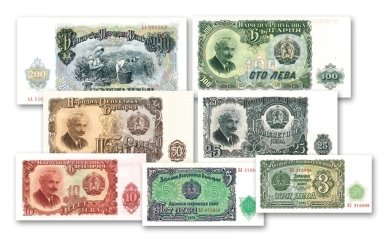
The Second Lev banknotes
The third lev emerged in 1962 after the due denomination of the Bulgarian currency with the exchange rate of 10:1. Then there was a long period of stability: the lev retained almost the same exchange rate in relation to the main world currencies. In 1978, it got its international code - BGL.
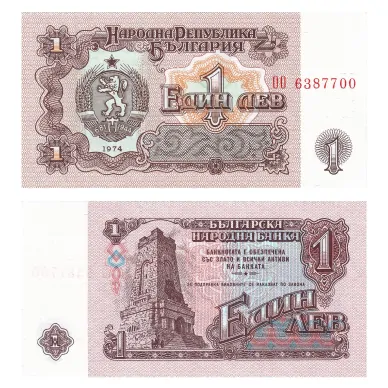
The Third Lev (BGL) banknote
In 1999, the era of the third lev ended. After its denomination of 1,000:1, the fourth lev was introduced - the official currency of modern Bulgaria.
The new lev was pegged to the Deutsche Mark, yet circulating at that time. However, the ISO code has been changed to BGN. When the euro substituted the mark, the lev became pegged to it with the fixed exchange rate of 1.955:1.
In 2005, Bulgaria joined the EU and pledged to switch to the euro in all payments. The transition had to take place in 2012, but the devaluation of the Bulgarian currency and instability of the national economy made this impossible.
The Fourth Lev Design
In 1999, the last denomination of the Bulgarian lev took place. Since then, the banknotes have been issued in denominations from 1 to 100 BGN. In 2016, one-lev banknotes were withdrawn from circulation because of the high level of inflation.

The other denominations were re-issued several times in the 2000s:
- 1 BGN is a red banknote that measures 112 mm by 60 mm and features Ivan Rilski on the obverse and the Rila Monastery on the reverse. The watermark depicts the rampant lion. One-lev banknote was withdrawn from circulation on January 1, 2016, and substituted with the coin of the same denomination.
- 2 BGN is a violet banknote that measures 116 mm by 64 mm and features Paìsiy Hilendàrski on the obverse and a fragment of his book on the reverse. The two-lev note was re-issued in 2005. At present, it begins to be withdrawn and becomes substituted with the two-lev coin.
- 5 BGN is a dark red banknote that measures 126 mm by 70 mm and features the artist Ivan Milev on the obverse and his paintings on the reverse. The watermark also depicts his portrait, which was complemented with БНБ abbreviation in 2008. The banknote was re-issued in 2009.
- 10 BGN is a green banknote that measures 126 mm by 70 mm and features Bulgarian doctor and scientist Petar Beron on the obverse and items of his researches and a microscope on the reverse. The watermark depicts his portrait, complemented with БНБ abbreviation. The banknote was re-issued in 2008.
- 20 BGN is a blue (issues of 1999, 2007, 2020) and violet (2005) banknote that measures 131 mm by 73 mm and 134 mm by 74 mm respectively. The obverse features the portrait of a revolutionary Stefan Stambolov. The reverse depicts the Orlov and Lavov bridges in Sofia and the National Assembly of Bulgaria. When the banknote was re-issued in 2007, the БНБ abbreviation appeared too.
- 50 BGN is a light-brown banknote, re-issued in 2006 and 2019, that measures 136 mm by 76 mm and features the portrait of Pencho Slaveykov on the obverse. The reverse includes his poems, the image of a bird, and the portrait of his beloved woman Mara Belcheva. The watermark constitutes the portrait of Pencho Slaveykov.
- 100 BGN is a green banknote, issued in 2003 and re-issued in 2018, that measures 141 mm by 79 mm. The obverse depicts the portrait of a writer Aleko Konstantinov. On the reverse, there are excerpts from his works in the background of his figure. The watermarks feature the writer’s portrait and БНБ abbreviation.
The coins of the fourth lev are minted in denominations of 1, 2, 5, 10, 20, and 50 stotinki. All of them have the same reverse that features the Madara rider. In 1999, the coins contained copper, aluminum, and nickel alloy. The following year, it was changed to bronze and steel.
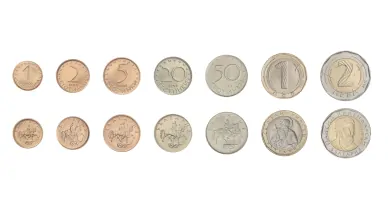
The Bulgarian Lev coins
Several 50-stotinka commemorative coins have been minted as a dedication to notable events in the country’s life, such as joining NATO or the EU. They were issued in 2004, 2005, and 2007.
The other significant event was the Bulgarian Presidency of the Council of the European Union in 2018. A two-lev coin was minted to commemorate the date.
Circulation in the World
The Bulgarian lev is not a reserve currency and is not preferred as a tool for exchange market transactions. Moreover, it undergoes constant devaluation because of the instability of the world economy.
The lev exchange rate is much dependent on the internal economic indices, which frequently change, not for the better.
FAQ
Why is the Bulgarian lev called lev?
The word "lev" means "lion" in Bulgarian, and the lion is a national symbol of Bulgaria.
Does Bulgaria still use the Lev?
Yes, Bulgaria still uses the lev as its official currency.
How is Bulgarian Lev written?
The Bulgarian Lev is written as "лев" in the Cyrillic script, which is used in the Bulgarian language. Its symbol is "лв."
Is Bulgarian Lev fixed to the euro?
Yes, the Bulgarian lev has a fixed exchange rate to the euro through a currency board arrangement. The fixed rate is 1 euro = 1.95583 leva.
Who is depicted on Bulgarian Lev banknotes?
Bulgarian Lev banknotes feature prominent Bulgarian historical figures, such as Khan Asparuh, Ivan Vazov, and Aleko Konstantinov, among others. The specific individuals can vary depending on the series of banknotes in circulation.
What are the different types of Bulgarian Lev?
The Bulgarian Lev comes in various denominations of banknotes and coins. Banknotes include 2, 5, 10, 20, 50, and 100 leva denominations. Coins include 1, 2, 5, 10, 20, and 50 stotinki, as well as 1 and 2 leva coins.







